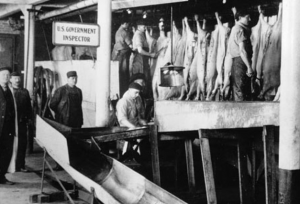
In 1906 a socialist leaning writer published a novel with the intent of promoting socialism by exposing the poor working conditions of immigrants in large Chicago packing houses. Side note: to this day big U.S. harvest plants are mainly manned by recent immigrants. Upton Sinclair’s efforts didn’t ever do much to promote socialism, but he has been credited with starting Federal Meat Inspection. During his later years Upton lamented that “I was aiming for their hearts, but hit their stomach.” Federal Meat Inspection has ever since been required for plants that sell products across State lines or for export. Individual State Inspection programs must be at least equal to the Federal program; State inspection programs are about 50% Federally funded. Small custom slaughter plants, those that process “not for sale” meat for the animal owner’s consumption, are exempt from Meat Inspection. However, facility plans for custom plants must be approved by the FSIS and once in operation they are subject to a monthly sanitary inspection (which may or may not happen). Retail outlets selling inspected meat cuts, or even further processed items made in-store from inspected meat, have a retail exemption from Meat Inspection. Local Boards of Health have jurisdiction in the massive and far-flung retail arena.
Meat Inspection begins with getting facility plans approved. Once harvest operations start-up inspection continues with an ante mortem (before death) look-over of slaughter animals. Non-ambulatory (downer) animals are not slaughtered for human consumption and otherwise sick looking ones are marked for careful post mortem carcass inspection. Random drug and chemical residue samples are also pulled by kill-floor inspectors. These procedures are either conducted by the plant assigned veterinarian or by federal lay inspectors that were trained by veterinarians. Veterinarians are also Meat Inspection supervisors. Lay inspectors have traditionally been former industry kill-floor employees and/or military veterans. After working a number of years on a kill-floor most lay inspectors gain promotions to further processing plants. More recently, CSI’s (Consumer Safety Inspectors) have been hired, while lacking kill-floor experience, because there are no longer very many slaughter plants in some regions of the U.S. (willingness to relocate issue). Further, meat industry consolidation into very large plants requires fewer overall kill-floor inspectors.
Regardless of the type of meat plant, inspectors conduct random pre-operation (pre-op) inspections, to assure daily sanitary conditions. Throughout the production day they watch for unsanitary procedures, unsafe working conditions, make sure plants are following their approved HACCP (Hazard Analysis and Critical Control Points) plan and monitor approved labels for product formulation accuracy. Meat inspection is taxpayer funded for up to 8 hours per scheduled shift during the basic work week. Overtime is charged to plants that opt to work past scheduled shift hours, on weekends or during any of the 10 Federal Holidays.
During the same era that brought about the advent of Meat Inspection there was an increasing need for uniform high quality meat in upscale restaurants & hotels; as well as on passenger ships. Meat quality characteristic benefits of grain feeding livestock were well known at that time, but without an unbiased third-party to evaluate carcass attributes the words grain-fed told the buyer little more than the term grass-fed tells today’s beef buyers. Aside from a high energy finishing period to fatten market animals, maturity level is also very important because it greatly effects meat toughness. Industry, academia and government came together at the time to research ways to read carcasses for predicting the palatability characteristics of flavor, tenderness & juiciness, and the percentage of actual meat a carcass would be expected to yield. Acting as an unbiased third party, in 1926 the USDA’s Agricultural Marketing Service (AMS) began offering the voluntarily grading of carcasses on a fee-for-service basis. Packers paying for grading services can select what carcasses they want evaluated and stamped (stamp ink is an edible dye). Today, carcass grading and fat trimming specifications allows business people to place meat orders from hundreds of miles away with a high degree of confidence in what will be delivered to them.
Perhaps because Meat Grading is self-funded on a voluntary usage basis, the majority of graders are either college graduates with Agricultural degrees and/or they worked as meat company grading advocates (taggers) for several years. In the biggest fat cattle plants the hourly charges for grading can figure out to less than 20 cents per head. However, low volume plants wanting grading a day or two a week might incur grader travel time expenses that make using this marketing tool cost prohibitive. During slow work times graders will go out and perform Public Law 272 reviews to help maintain meat industry confidence in the Federal grading program. To see the law and examples of violations click here. Besides carcass grading beef, lamb and veal (pork grading standards are not currently being used), graders also certify to specification the further processing of USDA donated meat (meat bought off the market to stabilize prices), into pre-cooked products for the school-lunch program. Further, graders do CN (Child Nutrition) label claim reviews and will conduct product exams for involved companies when in need of a factual unbiased opinion.
There are less than 200 red meat graders and the majority of them live in the “beef-patch,” near the biggest beef harvest plants. The beef-patch consist of a region encompassing most of Nebraska, Western Kansas, the Texas pan-handle and Eastern Colorado. Since there are thousands of Meat Inspectors scattered all around the more populated areas of the U.S. it is understandable that most people think Meat graders and Meat Inspectors are one in the same. Being one in the same is only true in a few small plants, far away from any established grading stations, where the local Meat Inspector is cross-trained to provide low volume carcass grading.
